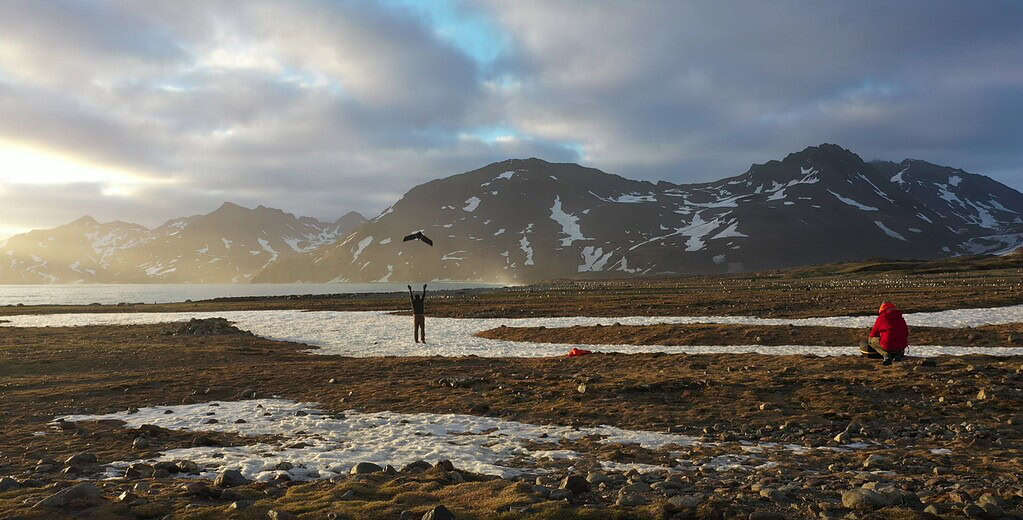 An aerial shot of the elephant seal colony at St Andrew’s Bay, one of the largest populations of southern elephant seals on South Georgia. Image credits: British Antarctic Survey.
An aerial shot of the elephant seal colony at St Andrew’s Bay, one of the largest populations of southern elephant seals on South Georgia. Image credits: British Antarctic Survey.
The beaches of South Georgia, a remote splinter of ice and rock in the South Atlantic, should be a place of deafening, chaotic life. Normally, the shores host the planet’s largest gathering of southern elephant seals, Mirounga leonina. They are the largest seals on Earth, and they come by the tens of thousands to fight, to mate, and to give birth.
In 2024, that cacophony was replaced by a chilling quiet.
A new study that used high-tech drones to survey these breeding grounds has delivered a staggering verdict. In the wake of the arrival of the deadly H5N1 avian flu, the number of breeding female elephant seals at the island’s three largest colonies has plummeted by an average of 47%.
Not Just for Birds Anymore
For years, scientists watched this virus with growing dread. This isn’t your average seasonal flu. The highly pathogenic avian influenza A virus (HPAIV) has jumped to cows, cats, and a concerningly large number of wild species.
Originating in 2020, the 2.3.4.4b clade tore through bird populations in Europe. It then hitched a ride on migratory birds, crossing the Atlantic to North America, leaving a trail of death. From there, it raced south, blazing through South America and triggering “mass mortalities” in seabirds and marine mammals along the coast.
For a time, the vast, stormy Southern Ocean acted as a shield for the Antarctic and sub-Antarctic regions. It was the last pristine continent, a fortress against the pandemic.
That fortress fell in 2023.
 Elephant seals stricken with avian flu at one of South Georgia’s largest colonies. Image credits: British Antarctic Survey.
Elephant seals stricken with avian flu at one of South Georgia’s largest colonies. Image credits: British Antarctic Survey.
In September 2023, the first suspected cases popped up in brown skuas on Bird Island, South Georgia. Several months later, it was confirmed in mammals: Antarctic fur seals and the southern elephant seals.
Unfortunately, the very life history of these seals makes them vulnerable. They are a “major predator” that lives a life of extremes, foraging deep in the Southern Ocean, only to haul out onto sub-Antarctic islands like South Georgia for one purpose: to breed.
But when they do breed, they gather in large colonies. Imagine thousands of animals packed shoulder-to-shoulder on a single beach. It’s a perfect transmission scenario for a respiratory virus. The 2023 breeding season was a nightmare. Reports from cruise ships and researchers described widespread death, with a particularly “catastrophic” 97% pup mortality observed in the Argentinian population at Peninsula Valdés.
Counting Seals
Researchers feared the worst, but it’s not easy to count such a large population. No one really knew the true toll on the adult population in South Georgia until now.
To get the real numbers, you can’t just count from a boat. The beaches are too big, the animals too numerous. So the scientific team turned to the sky. They used an uncrewed aerial vehicle (UAV), a fixed-wing drone, to fly programmed grids over the colonies. Flying at 90 meters, the drone snapped thousands of high-resolution images.
These images were then stitched together to create enormous maps. Then, on these maps, researchers manually tracked and counted every single animal. That’s how they observed the huge gap.
 A researcher launching a drone. Image credits: British Antarctic Survey.
A researcher launching a drone. Image credits: British Antarctic Survey.
The research team tried to consider other explanations, other than the avian flu. Could the seals have just… moved? The species has strong “philopatry,” meaning they return to the same beaches year after year. Perhaps the virus spooked them, and they scattered to smaller, “outlier” colonies? Or, could the 2023 trauma have broken the breeding cycle? After HPAIV caused massive pup deaths in 2023, perhaps the females, stressed and sick, abandoned the beaches early before they could even mate. This would mean fewer pregnancies, and therefore fewer females returning to give birth in 2024.
In the end, none of these alternative explanations were satisfactory. The researchers concluded that while these factors might have contributed, they “alone, or in combination, are unlikely to fully account for the dramatic decline”.
A 47% drop is simply too big to explain by “normal” circumstances. The timing also fit; it’s too much of a temporal overlap with the virus arriving to be a coincidence.
What Does This Mean for the Species?
The big, terrifying question is whether “missing” means “dead.”
The study counted females who “missed breeding”. For a species like this, female survival is the single most critical factor for population growth. While the authors can’t be certain every absent seal perished, they write that it is “probable that a significant portion of these absent seals have perished”.
The implications are grim.
Even if the virus magically disappears, the recovery could take decades. The adult females are long-lived animals, and a massive die-off has a disproportionate effect. Under the most severe scenarios, a full rebound is considered “unlikely before the next century”. Now, the world’s largest population at South Georgia faces the same bleak outlook.
The authors are blunt: the “long-term impact… is yet to be determined”. They call for “urgent,” “continued, intensive monitoring”. Researchers must return in 2025 and 2026 to see if any of the missing females come back, or if this 47% hole in the population is a permanent grave.
The study “Highly Pathogenic Avian Influenza Viruses (HPAIV) Associated with Major Southern Elephant Seal Decline at South Georgia” has been published in Communications Biology. https://doi.org/10.1038/s42003-025-09014-7

